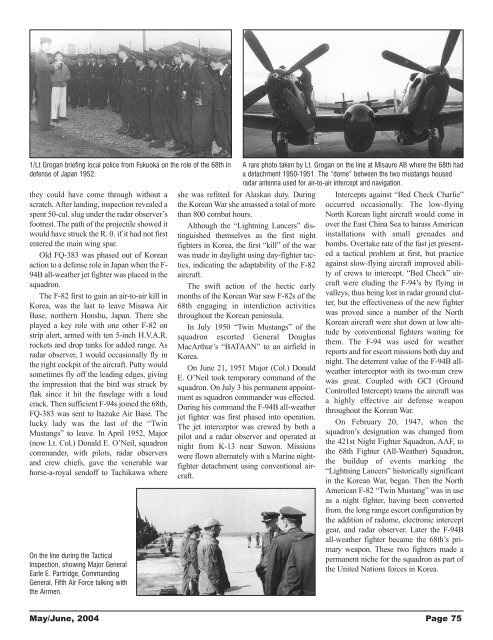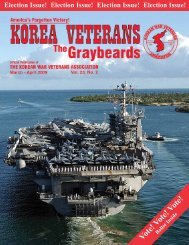The Graybeards - KWVA - Korean War Veterans Association
The Graybeards - KWVA - Korean War Veterans Association
The Graybeards - KWVA - Korean War Veterans Association
You also want an ePaper? Increase the reach of your titles
YUMPU automatically turns print PDFs into web optimized ePapers that Google loves.
1/Lt Grogan briefing local police from Fukuoka on the role of the 68th in<br />
defense of Japan 1952.<br />
they could have come through without a<br />
scratch. After landing, inspection revealed a<br />
spent 50-cal. slug under the radar observer’s<br />
footrest. <strong>The</strong> path of the projectile showed it<br />
would have struck the R. 0. if it had not first<br />
entered the main wing spar.<br />
Old FQ-383 was phased out of <strong>Korean</strong><br />
action to a defense role in Japan when the F-<br />
94B all-weather jet fighter was placed in the<br />
squadron.<br />
<strong>The</strong> F-82 first to gain an air-to-air kill in<br />
Korea, was the last to leave Misawa Air<br />
Base, northern Honshu, Japan. <strong>The</strong>re she<br />
played a key role with one other F-82 on<br />
strip alert, armed with ten 5-inch H.V.A.R.<br />
rockets and drop tanks for added range. As<br />
radar observer, I would occasionally fly in<br />
the right cockpit of the aircraft. Putty would<br />
sometimes fly off the leading edges, giving<br />
the impression that the bird was struck by<br />
flak since it hit the fuselage with a loud<br />
crack. <strong>The</strong>n sufficient F-94s joined the 68th,<br />
FQ-383 was sent to Itazuke Air Base. <strong>The</strong><br />
lucky lady was the last of the “Twin<br />
Mustangs” to leave. In April 1952, Major<br />
(now Lt. Col.) Donald E. O’Neil, squadron<br />
commander, with pilots, radar observers<br />
and crew chiefs, gave the venerable war<br />
horse-a-royal sendoff to Tachikawa where<br />
On the line during the Tactical<br />
Inspection, showing Major General<br />
Earle E. Partridge, Commanding<br />
General, Fifth Air Force talking with<br />
the Airmen.<br />
A rare photo taken by Lt. Grogan on the line at Misaure AB where the 68th had<br />
a detachment 1950-1951. <strong>The</strong> “dome” between the two mustangs housed<br />
radar antenna used for air-to-air intercept and navigation.<br />
she was refitted for Alaskan duty. During<br />
the <strong>Korean</strong> <strong>War</strong> she amassed a total of more<br />
than 800 combat hours.<br />
Although the “Lightning Lancers” distinguished<br />
themselves as the first night<br />
fighters in Korea, the first “kill” of the war<br />
was made in daylight using day-fighter tactics,<br />
indicating the adaptability of the F-82<br />
aircraft.<br />
<strong>The</strong> swift action of the hectic early<br />
months of the <strong>Korean</strong> <strong>War</strong> saw F-82s of the<br />
68th engaging in interdiction activities<br />
throughout the <strong>Korean</strong> peninsula.<br />
In July 1950 “Twin Mustangs” of the<br />
squadron escorted General Douglas<br />
MacArthur’s “BATAAN” to an airfield in<br />
Korea.<br />
On June 21, 1951 Major (Col.) Donald<br />
E. O’Neil took temporary command of the<br />
squadron. On July 3 his permanent appointment<br />
as squadron commander was effected.<br />
During his command the F-94B all-weather<br />
jet fighter was first phased into operation.<br />
<strong>The</strong> jet interceptor was crewed by both a<br />
pilot and a radar observer and operated at<br />
night from K-13 near Suwon. Missions<br />
were flown alternately with a Marine nightfighter<br />
detachment using conventional aircraft.<br />
Intercepts against “Bed Check Charlie”<br />
occurred occasionally. <strong>The</strong> low-flying<br />
North <strong>Korean</strong> light aircraft would come in<br />
over the East China Sea to harass American<br />
installations with small grenades and<br />
bombs. Overtake rate of the fast jet presented<br />
a tactical problem at first, but practice<br />
against slow-flying aircraft improved ability<br />
of crews to intercept. “Bed Check” aircraft<br />
were eluding the F-94’s by flying in<br />
valleys, thus being lost in radar ground clutter,<br />
but the effectiveness of the new fighter<br />
was proved since a number of the North<br />
<strong>Korean</strong> aircraft were shot down at low altitude<br />
by conventional fighters waiting for<br />
them. <strong>The</strong> F-94 was used for weather<br />
reports and for escort missions both day and<br />
night. <strong>The</strong> deterrent value of the F-94B allweather<br />
interceptor with its two-man crew<br />
was great. Coupled with GCI (Ground<br />
Controlled Intercept) teams the aircraft was<br />
a highly effective air defense weapon<br />
throughout the <strong>Korean</strong> <strong>War</strong>.<br />
On February 20, 1947, when the<br />
squadron’s designation was changed from<br />
the 421st Night Fighter Squadron, AAF, to<br />
the 68th Fighter (All-Weather) Squadron,<br />
the buildup of events marking the<br />
“Lightning Lancers” historically significant<br />
in the <strong>Korean</strong> <strong>War</strong>, began. <strong>The</strong>n the North<br />
American F-82 “Twin Mustang” was in use<br />
as a night fighter, having been converted<br />
from. the long range escort configuration by<br />
the addition of radome, electronic intercept<br />
gear, and radar observer. Later the F-94B<br />
all-weather fighter became the 68th’s primary<br />
weapon. <strong>The</strong>se two fighters made a<br />
permanent niche for the squadron as part of<br />
the United Nations forces in Korea.<br />
May/June, 2004 Page 75
















